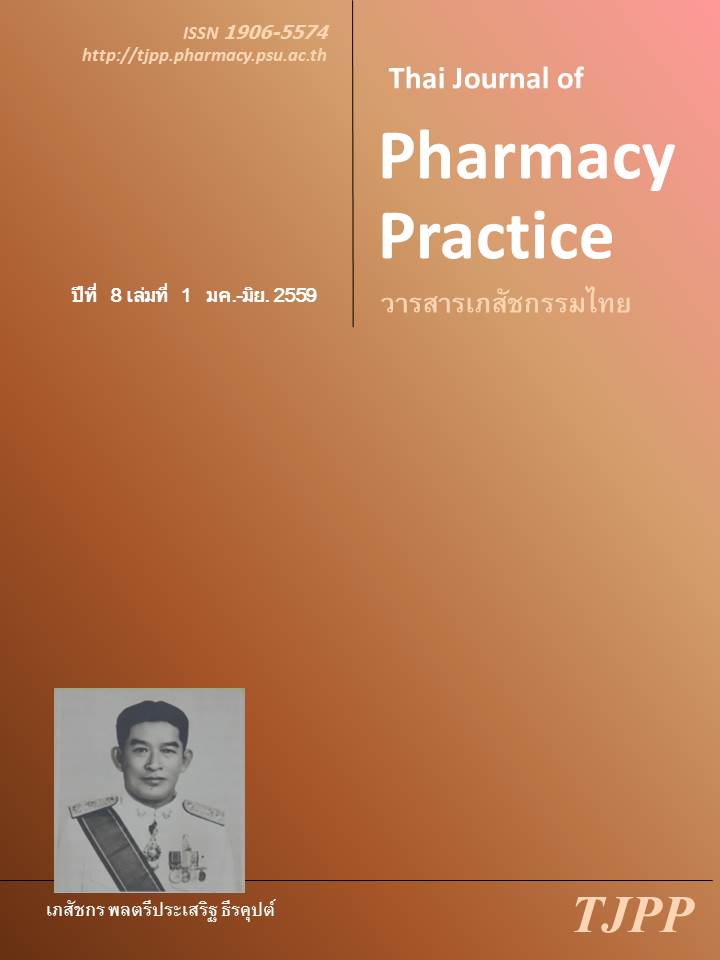การประเมินผลการเยี่ยมบ้านโดยทีมสหวิชาชีพที่มีเภสัชกรร่วมทีมเพื่อจัดการปัญหาการใช้ยา ในผู้ป่วยเบาหวานและความดันโลหิตสูงของโรงพยาบาลน้ำพอง จังหวัดขอนแก่น
Main Article Content
บทคัดย่อ
วัตถุประสงค์: เพื่อเปรียบเทียบสัดส่วนของการเกิดปัญหาจากการใช้ยาและผลลัพธ์ทางคลินิกในผู้ป่วยเบาหวานและความดันโลหิตสูงที่ควบคุมอาการได้ไม่ดีหรือมีปัญหาการใช้ยา ระหว่างก่อนและหลังการเยี่ยมบ้าน และประเมินความพึงพอใจของผู้ป่วยต่อการเยี่ยมบ้านของเภสัชกร วิธีการศึกษา: การวิจัยนี้เป็นการศึกษากึ่งทดลอง เภสัชกรออกเยี่ยมบ้านร่วมกับทีมสหวิชาชีพระหว่างพฤศจิกายน 2557 ถึง กรกฎาคม 2558 ในกลุ่มผู้ป่วยเบาหวานและความดันโลหิตสูงที่คุมอาการได้ไม่ดีหรือมีปัญหาการใช้ยา การเยี่ยมบ้านมีทั้งหมด 3 ครั้งในผู้ป่วยแต่ละราย (เดือนที่ 0, 3, 6) เภสัชกรทำหน้าที่ติดตามปัญหาการใช้ยา บันทึกความดันโลหิตที่วัดได้ ระดับน้ำตาลหลังงดอาหารและระดับน้ำตาลสะสมจากสมุดของผู้ป่วย และประเมินความพึงพอใจด้วยวิธีการสัมภาษณ์ ผลการศึกษา: ผู้ป่วยทั้งหมด 90 รายได้รับการเยี่ยมบ้าน ผู้ป่วยส่วนใหญ่เป็นเพศหญิง (ร้อยละ 80.0) เป็นโรคเบาหวานร่วมกับความดันโลหิตสูงโดยมีหรือไม่มีโรคอื่นร่วมด้วย (ร้อยละ 84.4) มีอายุเฉลี่ย 68.9±7.0 ปี และได้รับยา ≥ 5 รายการ (ร้อยละ 61.1) ปัญหาการใช้ยาที่พบส่วนใหญ่ คือ ความไม่ร่วมมือในการใช้ยา ซึ่งพบทั้งหมด 175 เหตุการณ์ (ร้อยละ 98.3 ของปัญหาทั้งหมด) หลังเยี่ยมบ้านปัญหานี้ลดลงเหลือ 33 เหตุการณ์ (ลดลงร้อยละ 81.1) ค่ามัธยฐานระดับน้ำตาลในเลือดสะสม (n=76) ลดลงจากร้อยละ 9.9 เป็นร้อยละ 9.0 (P<0.001) ความดันโลหิตขณะหัวใจบีบตัวและคลายตัว (n=55) ลดลงจาก 140.0 และ 90.0 มิลลิเมตรปรอทเป็น 130.0 และ 85.0 มิลลิเมตรปรอทตามลำดับ (P<0.001) ผู้ป่วยมากกว่าร้อยละ 65 มีความพึงพอใจระดับมากหรือมากที่สุดต่อการร่วมทีมเยี่ยมบ้านของเภสัชกรในด้านกระบวนการเยี่ยมบ้าน ตัวเภสัชกร และผลการรักษา สรุป: การเยี่ยมบ้านโดยทีมสหวิชาชีพที่มีเภสัชกรร่วมทีมช่วยลดปัญหาการใช้ยาและเพิ่มผลลัพธ์ทางคลินิกของผู้ป่วยเบาหวานและความดันโลหิตสูง บริการนี้เป็นที่พึงพอใจต่อผู้ป่วย ดังนั้นจึงควรสนับสนุนให้มีบริการต่อไป
Article Details
ผลการวิจัยและความคิดเห็นที่ปรากฏในบทความถือเป็นความคิดเห็นและอยู่ในความรับผิดชอบของผู้นิพนธ์ มิใช่ความเห็นหรือความรับผิดชอบของกองบรรณาธิการ หรือคณะเภสัชศาสตร์ มหาวิทยาลัยสงขลานครินทร์ ทั้งนี้ไม่รวมความผิดพลาดอันเกิดจากการพิมพ์ บทความที่ได้รับการเผยแพร่โดยวารสารเภสัชกรรมไทยถือเป็นสิทธิ์ของวารสารฯ
เอกสารอ้างอิง
2. Couney N. Literature review: The current situation and care model of non-communicable diseases. Nonthaburi: Institute of Medical Research and Technology Assessment, 2014.
3. World Health Organization. The world health report 2008: primary health care-now more than ever. Geneva, Switzerland: World Health Organization, 2008.
4. Ministry of Public Health. A plan for developing health service system 2012-2017 [online]. 2012. [cited Jan 5, 2016]. Available from: plan.hss.moph .go.th/display_document.jsp?id=D00000000637.
5. Leesathapornwongsa P. Action plan of role of primary care pharmacy in universal coverage system [online]. 2011. [cited Jan 5, 2016]. Available from: thaihp.org/index2.php?option=show file&tbl=home&id=697.
6. Primary Care Pharmacy Working Group. Handbook for pharmacists working in primary care units. Bangkok: Office of Health Consumer Protection Plan, 2011.
7. National Health Security Office Area 7 at Khon Kaen. A handbook for developing primary care system in the fiscal Year 2014. Khon Kaen: National Health Security Office Area 7 Khon Kaen, 2014.
8. Ensing HT, Koster ES, Stuijt CCM, van Dooren AA, Bouvy ML. Bridging the gap between hospital and primary care: the pharmacist home visit [commentary]. Int J Clin Pharm 2015; 37: 430–4.
9. Peterson GM, Fitzmaurice KD, Naunton M, Vial JH, Stewart K. Impact of pharmacist-conducted home visits on the outcomes of lipid-lowering drug therapy. J Clin Pharm Ther 2005; 29: 23-30.
10. Thaungsuwan W, Jedsadayanmata A. Effect of pharmacist participation in multidisciplinary team for home visit on blood pressure and drug adherence of stroke patients. Thai Journal of Pharmacy Practice 2016; 8: 48-57.
11. Rachaniyom S, Saramunee K. Family pharmacist’s management of drug related problems for chronic diseases at patient’s in home, Kranuan district health network. Thai Journal of Pharmacy Practice 2016; 8: 169-81.
12. American Diabetes Association. Standards of medical care in diabetes-2016. Diabetes Care 2016; 39(suppl 1): S1-S106.
13. James PA, Oparil S, Carter BL, Cushman WC, Dennison-Himmelfarb C, Handler J, et al. Evidence-based guideline for the management of high blood pressure in adults report from the panel members appointed to the eighth joint national committee (JNC 8). JAMA 2014; 311: 507-20.
14. Ningsanon T, Monthakarnkul P, Wanakmanee U, Suansanea T, Chatuporn T, editors. Textbook of family pharmacist. Bangkok: The Association of Hospital Pharmacy (Thailand), 2014.
15. Hepler CD, Strand LM. Opportunities and responsibilities in pharmaceutical care. Am J Hosp Pharm 1990; 47: 533-43.
16. Weerawattanachai C. Factors affecting drug related problems in diabetic inpatients at Rajavithi hospital [master thesis]. Bangkok: Chulalongkorn University, 2002.
17. Hajjar ER, Cafiero AC, Hanlon JT. Polypharmacy in elderly patients. Am J Geriatr Pharmacother 2007; 5: 345-51.
18. Mamun K, Lien CTC, Goh-Tan CYE, Ang WST. Polypharmacy and inappropriate medication use in Singapore nursing home. Ann Acad Med Singapore 2004; 33: 49-52.
19. Shrestha R, Pant A, Shakya SS, Shrestha B, Gurung RB, Karmacharya B. A cross-sectional study of medication adherence pattern and factors affecting the adherence in chronic obstructive pulmonary disease. Kathmandu Univ Med J 2015; 13: 64-70.
20. Chaimay B, Boonrod T, Simla W. Factors affecting herbal uses in primary health care. Public Health Journal of Burapha University 2012; 7: 25-35.
21. Sirithanawuthichai T, Wongsaowasup A, Nopuan W, Kruenak T. The effectiveness of village health volunteers in Muang District, Mahasarakham. Journal of Science and Technology Mahasara- kham University 2010; 29: 439-45.
22. Zermansky AG, Alldred DP, Petty DR, Raynor DK, Freemantle N, Eastaugh J, et al. Clinical medication review by a pharmacist of elderly people living in car homes-randomised controlled trial. Age Ageing 2006; 35: 586-91.
23. Pharmaceutical Society of Australia. Guidelines for pharmacists providing home medicines review (HMR) services. Deakin West: Pharmaceutical Society of Australia Ltd, 2011.
24. Pharmaceutical Services Negotiating Committee. Medicines use review (MUR) [online]. 2014. [cited Apr 29, 2016]. Available from: psnc.org.uk/service s-commissioning/advanced-services/murs/.
25. White L, Klinner C, Carter S. Consumer perspectives of the Australian home medicines review program: benefits and barriers. Res Social Adm Pharm 2012; 8:4-16.
26. Stamler J, Rose G, Stamler R, Elliott P, Dyer A, Marmot M. INTERSALT study findings: public health and medical care implications. Hyper- tension 1989; 14: 570-7.
27. Fiß T, Meinke-Franze C, van den Berg N, Hoffmann W. Effects of a three party healthcare network on the incidence levels of drug related problems. Int J Clin Pharm 2013; 35: 763–71.


